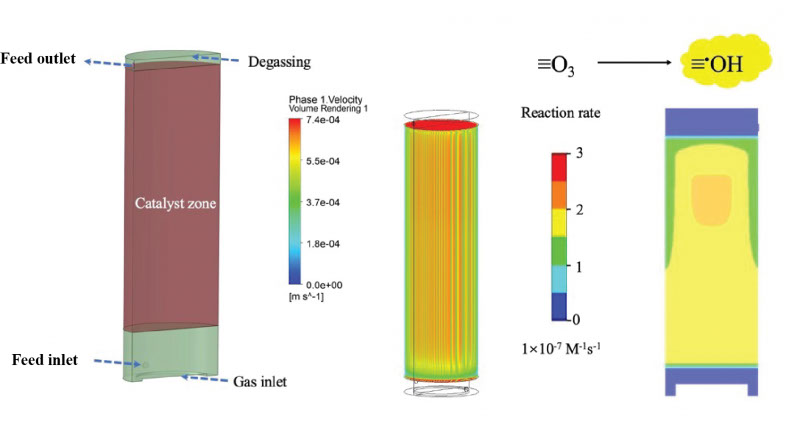Newsletter November 2022
Research updates
Research updates

The wide range of recalcitrant organic contaminants in wastewaters combined with the Government's carbon neutrality policy require versatile and flexible treatment technologies with low carbon footprint to cope with the strict discharge and/or reclamation standards. O3-based AOPs have been recognized as promising technologies for contaminant removal and, as such, have been extensively applied in wastewater decontamination. This team at CTET led by Professor David Waite has made some progress in developing diverse O3-oriented AOPs to treat various industrial wastewaters.
Nano-sized Cu-based ozonation catalysts have been developed and shown to be effective in degrading refractory organic compounds, including those present in coal chemical wastewaters. A lab-scale ozonation reactor equipped with effective mixing and separation functions has been constructed and is currently being used for tests with these recently developed Cu-based catalysts.
Figure 3. Water tasting by the visitors
Figure 2. Professor Waite showcasing the CTET mCDI unit to the visitors
Figure 4. Professor David Waite and Warwick Dawson with visitors from the People’s Republic of China’s Embassy in Australia in front of the mCDI unit in Ali Curung
The UNSW China Learning Centre (CLC) held the first summer camp (U-week) for new students from 14th-18th August at the UNSW Centre for Transformational Environmental Technologies (CTET), Yixing, Jiangsu. The U-week attracted students undertaking a variety of majors and enabled them to have a sip of college life before departure to the Sydney campus.
On the opening day of the U-week, Professor Anne Simmons, UNSW Provost, Scientia Professor David Waite, CEO of CTET, and Dr Yuan Wang, general manager of CTET delivered opening speeches to welcome the students attending the U-week. A wide rang of interactive activities were arranged such as presentations by experienced graduates to share vital information on moving to Australia and setting up a new life in Sydney, provision of an example of online teaching by UNSW lecturers, and a virtual tour of UNSW laboratories using cutting edge VR technology. Students attending the camp were also given an insight into the local culture of the “Ceramic Capital” (Yixing) by taking part in Zisha pot-making and local company visits. By all reports, the students enjoyed the summer camp experience and provided positive feedback that will greatly assist preparation of future camps. The next camp will be held in February 2023 with the application link to be provided soon. Please follow our official Wechat account (UNSW CTET) for the updates.
CTET recently published a research paper entitled “Boron Removal from Reverse Osmosis Permeate Using an Electrosorption Process: Feasibility, Kinetics, and Mechanism” in Environmental Science & Technology. This work presents an asymmetric, membrane-containing flow-by electrosorption system for boron removal. Upon charging, the catholyte pH rapidly increases to above ∼10.7 as a result of water electrolysis and other Faradaic reactions with resultant deprotonation of boric acid to form B(OH)4– and subsequent removal from solution by electrosorption to the anode. Results also show that the asymmetric flow-by electrosorption system is capable of treating feed streams with high concentrations of boron and RO permeate containing multiple competing ionic species. On the basis of the experimental results obtained, a mathematical model has been developed that adequately describes the kinetics and mechanisms of boron removal by the asymmetric electrosorption system. Overall, this study not only provides new insights into boron removal mechanisms by electrosorption but also opens up a new pathway to eliminate amphoteric pollutants from contaminated source waters.
CTET published another research paper entitled “Analysis of Ozonation Processes Using Coupled Modeling of Fluid Dynamics, Mass Transfer, and Chemical Reaction Kinetics” in Environmental Science & Technology. A 3D computational fluid dynamics (CFD) model incorporating both multi-phase flow and reaction kinetics describing ozone decay, hydroxyl radical (•OH) generation, and organic oxidation was developed to simulate the performance of continuous flow ozonation reactors. Simulation results revealed that the dissolved ozone concentration in the reactor is controlled by rates of O3(g) interphase transfer and ozone self-decay. Complete utilization of gas phase ozone was hard to achieve due to the low ozone interphase mass transfer rate. The CFD model adequately describes the mass transfer occurring in the two-phase flow system and confirms that O3(g) interphase mass transfer is the rate-limiting step in contaminant degradation. The model can be used to optimize the ozone reactor design for improved contaminant degradation and ozonation efficiency.
On Thursday, 11 August 2022, the Minister Counsellor and the third Secretary from the People’s Republic of China’s Embassy in Australia visited the pilot scale mCDI unit manufactured through UNSW Centre for Transformational Environmental Technologies (CTET) and currently under trial in Ali Curung, a remote community in Central Australia. The visit was accompanied by Professor David Waite, Dr Yuan Wang and Mr. Warwick Dawson, Director of Knowledge Exchange, UNSW Sydney and engineers from the Power and Water Corporation in Northern Territory.
Ali Curung has a population of 600 people who rely completely on the local groundwater for their drinking water supply. CTET’s mCDI unit is co-located with Power and Water’s Advanced Water Treatment Plant in Ali Curung, providing drinking water to the indigenous people in the community.
Professor Waite explained the working mechanisms of mCDI and the advances made by the UNSW and CTET research team on the system design and integration to the visitors. The Minister Counsellor also tasted the water produced directly from the tap from the mCDI unit and confirmed its acceptability.
The General Manager of Strategic Services from Wannon Water, a regional Victorian water corporation, also joined the trip. Wannon Water is committed to improving the aesthetic quality of local groundwater supplies to improve community health and reduce cost of living. The CTET mCDI units offer a novel solution and discussions have commenced about a possible Victorian trial
After the site visit, the Minister Counsellor and the third Secretary also both tried the augmented reality (AR) mCDI unit developed by the CTET team and used to monitor and control the unit remotely.
Please click the following to download the PDF version of the Newsletter Issue 2: